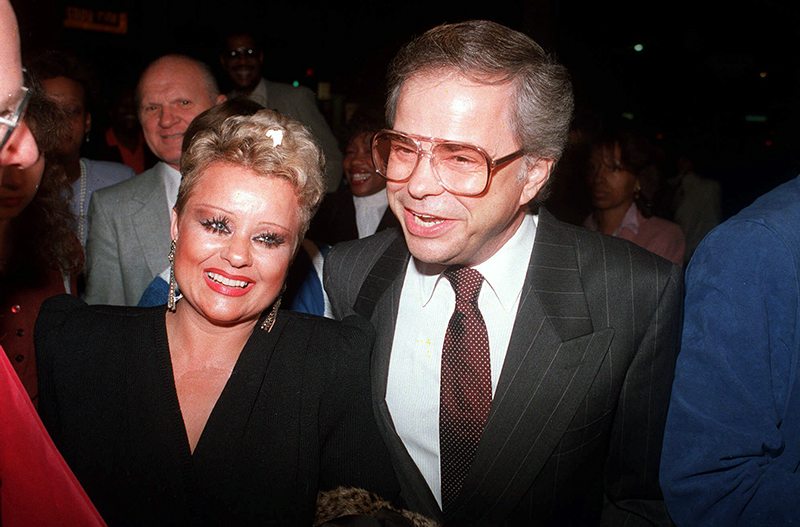
(RNS) — The jingle for the 40th birthday celebration for Tammy Faye Bakker on The PTL Club in 1982 is perhaps the most concise summation of her personality and her message ever spoken: “It’s Tammy, a double whammy of turnin’ on Christian love.”
Throughout her long career, Tammy Faye Messner (née LaValley, formerly Bakker) was “extra” before extra was a category. She wore layers of makeup (especially mascara). She had a high-pitched, childlike voice, a nervous giggle and enormous, expressive eyes that teared up at a moment’s notice. She wore expensive clothes and was conspicuous in her consumption.
She could do so because, with her first husband Jim, she created PTL (“Praise the Lord”), a Christian media empire reaching tens of millions worldwide and pioneering the televangelist ministry scene.
They were also exemplars of the sex, drugs and money scandals that followed. Tammy watched as it crumbled and her spouse was convicted of fraud. In the years that followed, for many, the Bakker name became synonymous with vanity, corruption and excess.
RELATED: Actress Jessica Chastain looked at more than ‘The Eyes of Tammy Faye’ for new movie
In a new movie, “The Eyes of Tammy Faye,” based on the documentary of the same name, Jessica Chastain creates a counter-narrative to the cartoonish lampooning Tammy Faye received in the years following the downfall of PTL. The film is a sympathetic portrayal that focuses on her lifelong aims to extend and receive Christian love to everyone — especially, and controversially, to gay men suffering from AIDS.

Actor Jessica Chastain portrays Tammy Faye Bakker in the upcoming biopic, “The Eyes of Tammy Faye.” Photo courtesy Searchlight Pictures
The focus on Tammy Faye’s interior world gives viewers a portrait of a woman of resilience, strength and vulnerability. Chastain’s portrayal of Tammy Faye is arresting; she is a funny, intelligent, good-hearted woman, and viewers get an idea of her resilience. But seeing the world through Tammy’s eyes means that the film doesn’t fully explain her ingenuity and power.
Most of the film’s critical events take place during the height of the Bakkers’ success, a curious moment for American Protestantism, celebrity culture and political activism in the late 20th century. It was not clear, in the early days of televangelism, which version of tele-Christianity would resonate most with the general public.
What was clear was that the conservative white Protestants vying to rule the airwaves all understood that, on some level, they were in competition with one another when it came to “reaching souls.” In the movie’s telling, Baptists Jerry Falwell and Pat Robertson and their Pentecostal colleagues Jimmy Swaggart, Jim Bakker and Tammy Faye Bakker represent overlapping, sometimes conflicting visions of the gospel for the masses.
Falwell’s stern, patriarchal voice fights to be “God’s voice” to save America by defeating the “liberal agenda, the feminist agenda, homosexual agenda.” Robertson’s charismatic Baptist ambition to save the nation by presiding over it are transparent behind his tidy suits and ties (in the end, Robertson’s TV presence was the most enduring).
Swaggart’s gospel singing and devil busting is in the background of the film, but Jim Bakker’s pentecostal visions of God’s lavish generosity and prosperity are visible in every elaborate set piece and in his dreams of creating Heritage U.S.A., a Christian theme park. A clear contrast to Falwell’s and Robertson’s militant posture, Tammy Faye’s effusive message about God’s acceptance and love are present in every tearful interview.
Historian Doug Weaver has chronicled the sometimes friendly, sometimes antagonistic relationship between Baptists and Pentecostals in the 20th century. Baptists of a certain ilk, Weaver shows, enjoyed dominance in mid-20th century public life (the Rev. Billy Graham was, after all, a Southern Baptist!), while as comparative newcomers to the national scene, Pentecostals were the upstarts.

Jim and Tammy Faye Bakker enjoy a night on the town on Oct. 24, 1987, as they arrive at the Beverly Theatre to see the show “The Gospel Truth.” (AP Photo/Douglas C. Pizac)
Pentecostals were naturals, however, when it came to mass media. In “PTL: The Rise and Fall of Jim and Tammy Faye Bakker’s Evangelical Empire,” John Wigger shows how the Bakkers outstripped other broadcasters with brilliant marketing and media innovation.
This competition is the religious backstory of “The Eyes of Tammy Faye.” Baptists Falwell and Robertson try to appear to play nice, but they are clearly uncomfortable with the emotive Swaggart and flamboyant Bakker. Tammy Faye flummoxes them altogether.
Rather than assent to fundamentalist gender hierarchies of the era, Tammy Faye works “outside the home” alongside her husband; she’s loud, ambitious and arguably more talented than her husband. In the film, Vincent D’Onofrio’s Falwell is annoyed with her but assumes that she will do her wifely duty, raise her kids and fade into the background.
But Tammy Faye is certainly not a Southern Baptist wife. She is at her core a tongue-speaking, God-hearing Pentecostal woman, authorized to minister by a tradition with a high tolerance for scandal-ridden celebrity women preachers.
Decades before Tammy Faye Bakker hit television, Aimee Semple McPherson was doing the same on the radio in the 1920s and 1930s. A Pentecostal preacher as well as a brilliant, camera-friendly self-promoter with an international following, Semple adopted an exaggeratedly feminine persona animated by early 20th-century notions of white womanhood, adding for good measure a favorite biblical figure in Pentecostal circles — the eschatological Bride of Christ.
McPherson regularly preached about Jesus as a loving healer. For years, the twice-divorced McPherson was also at the center of sex scandals, financial drama and criminal trials. Yet McPherson’s followers largely remained steadfast. They loved her and her Jesus, and they felt that she loved them, allowing her to transcend expectations for womanliness and ministry, just like Tammy Faye Bakker in the 1980s.
RELATED: What Jerry and Becki Falwell can learn from Jim and Tammy Bakker
“The Eyes of Tammy Faye” omits these followers, the regular people who loved Tammy Faye passionately and funded PTL. Ask those connected to the Bakkers’ ministry — a woman who worked with Jessica Hahn (Jim Bakker’s accuser, who is barely mentioned in the film and is largely forgotten in Pentecostal circles); a man who was one of the Bakkers’ drivers; a grandmother who gave a monthly percentage of her Social Security to create Heritage U.S.A. — and in every case, it is Tammy Faye who made a mark on their lives.
Certainly there are those who still feel betrayed, but even those who cannot and will not forgive Jim (and there are many) tend to have a soft spot for Tammy Faye.

Actors Andrew Garfield and Jessica Chastain as the famous televangelist couple, Jim and Tammy Faye Bakker, in the biopic, “The Eyes of Tammy Faye.” Photo courtesy Searchlight Pictures
This power of enduring, accepting love must be seen to be believed. Chastain’s performance will no doubt garner praise, but there is nothing quite like watching the real Tammy Faye. The actual footage of Tammy Faye Bakker talking with the Rev. Steve Pieters about being a gay man living with AIDS is riveting, especially when you understand the political and theological stakes of that era. While Falwell’s Moral Majority Report was arguing that “Homosexual Diseases Threaten America’s Families,” Tammy Faye was warmly conversing with Pieters and embracing him as a brother in Christ.
The film frames Falwell’s response to that interview as sexism. It’s also fair to interpret his aggression as a proportionate response to a serious threat to his own theological and political agenda. Perhaps Falwell saw in Tammy Faye’s relationship with her audience and in her significant charisma something that could directly challenge his own prominence and work.
Given the precipitous decline of the Bakkers (and Falwell’s role in facilitating their demise), it is tempting to believe that Falwell’s better-organized, well-disciplined operation ensured that his vision would win the day or that Jim Bakker’s salesmanship and ongoing legal troubles would be the Bakkers’ lasting legacy. Yet, historian Arlene M. Sánchez Walsh depicts Tammy Faye Messner’s son, Jay Bakker, as carrying on the message of his mother.
It seems fitting that, as one of the original creators of reality television, one of Tammy Faye’s last public appearances was on The Surreal Life. There, alongside fellow celebrity misfits Vanilla Ice, Ron Jeremy and Eric Estrada, the perpetually underestimated Tammy Faye wowed her audience with Pentecostal preaching about the love and acceptance of God.
“I thought she was going to be a Bible-beater and judge me,” said castmate Trishelle Cannatella, “but she took care of me.”
(Dr. Leah Payne, PhD, Vanderbilt University, is associate professor of American religious history at Portland Seminary. Her first book “Gender and Pentecostal Revivalism: Making a Female Ministry in the Early Twentieth Century” (Palgrave Macmillan, 2015) won the Pneuma: the Journal of the Society for Pentecostal Studies 2016 Book Award. The views expressed in this commentary do not necessarily represent those of Religion News Service.)
